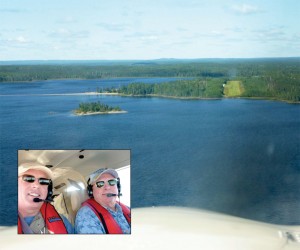
As host of the “Midwest Flyer Canadian Fishing Fly-Out,” August 17-22, I can assure you that if anyone on the trip had a complaint, I would have heard about it. Participants that have been on the fly-out before commented that this was the best trip ever!
The fly-out attracted more planes and pilots than any previous fly-out. Nine planes and 21 pilots and guests enjoyed the four-day, four-night trip to Miminiska Lodge in northern Ontario. This was the sixth consecutive fly-out hosted by Midwest Flyer Magazine, and interest has grown so much that two trips are scheduled for 2011.
The fly-out was created on the basis that pilots want to take a cross-country flight outside their normal surroundings for the challenge and personal enjoyment. When you combine such a flight with the great outdoors, you have an adventure!
Proper flight planning and preparation is essential, from knowing your weight and balance, and customs and border protection procedures, to learning what to expect when flying in sparsely populated areas.
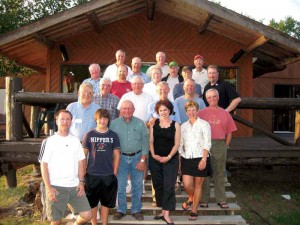
This year’s trip attracted pilots from Wisconsin, Iowa and Michigan. Among the planes were two Piper Archers, two Cessna 182s, two Piper Cherokees, a Grumman Tiger, a Mooney Ovation, and a Beechcraft Bonanza.
Miminiska Lodge is located along the Albany River watershed, 196 nm north of Thunder Bay, Ontario. This was our fourth trip to Miminiska and we will be back in 2011.
Of the five lodges with airstrips I have flown to over the years, Miminiska is simply the best facility for this fly-out. It has a 2400 ft. grass airstrip, the accommodations and service is exceptional, and our special group rate makes it affordable.
I’ve flown to lodges further into Canada, but weather and fuel availability can be an issue. I have also flown to lodges closer to the United States/Canada border, but those trips were too easy. Miminiska is located far enough into Canada to make the trip an adventure, yet not so far as to keep the novice pilot from participating.
As a personal flight planning tool for myself, and to help other pilots with their flight planning, I have written a “Flight Plan Guide” that includes information all pilots must know, identifies airports along the route of flight, lists radio frequencies and procedures to follow, and describes U.S. and Canada custom procedures. The guide is but one resource for pilots to consider. Additional information is available from the Aircraft Owners & Pilots Association, the Federal Aviation Administration, and the Canada Flight Supplement published by the government agency Nav Canada.
Included in the guide is information on enrolling in the Homeland Security/U.S. Customs & Border Protection (CBP) electronic “Advance Passenger Information System (eAPIS). Once you register online and complete your first “Flight Manifest,” which is similar to an FAA flight plan, each subsequent Flight Manifest becomes easier. For additional information about eAPIS, refer to https://eapis.cbp.dhs.gov/.
To make life easier and to avoid any last-minute issues, it is recommended that you complete your “Traveler Manifests” with U.S. Customs & Border Protection for both your outbound and inbound legs, and file your outbound U.S. flight plan to Canada, the day before you leave on the trip. You also need to call Canada Customs with your ETA into Canada by calling 1-888-CAN-PASS (226-7277) at least 2 hours before arriving, and no more than 48 hours in advance. To re-enter the U.S., call U.S. Customs & Border Protection at your airport of entry at least 1 hour in advance and confirm or update your ETA as filed on your inbound Flight Manifest. Confirmation of your ETA is necessary to ensure that a customs official will be present upon your arrival. There is no way to modify a Flight Manifest should it become necessary to change dates, pilots or passengers, so if this occurs, you will need to file a new Flight Manifest, and the old Flight Manifest will automatically expire.
To simplify our flight planning in 2011, we will file our flight plans “online” from Miminiska Lodge for the return flight, rather than call in our flight plans using the computer telephone system “Skype.” To register to file flight plans online with Nav Canada, go to www.flightplanning.navcanada.ca.
With our planes loaded and fueled, all we needed to do on the day of our departure from the U.S. was check weather, NOTAMS, TFRs, and go!
Last year most pilots flew to Ely, Minnesota (KELO), the night before we crossed the border into Canada. This year we flew to Thunder Bay, Ontario, the day before we flew to Miminiska, cleared Canada Customs, topped off our tanks, and stayed at the Valhalla Inn in Thunder Bay. The Valhalla provides shuttle service between the airport and hotel, and is located just off airport property.
Those of us who flew to Ely for fuel before crossing the border used the Remote Communications Outlet (RCO) at Ely to contact Princeton Radio to open our flight plans, and obtain a discrete transponder code (FSS obtains the code from Minneapolis Center). Once airborne, we contacted Princeton Radio on 122.1 and listened over the Ely VOR on 109.6, as we crossed the border. Pilots are required to maintain radio contact with either Flight Service or Air Traffic Control while crossing the border, as required by U.S. Customs & Border Protection, the Federal Aviation Administration, and the North American Air Defense Command (NORAD). To reach Minneapolis Center directly to obtain a squawk code, you have to be at least 5,000 feet MSL, so working through Princeton FSS works the best. Besides, if flying VFR to Thunder Bay, you have to activate your flight plan with Princeton anyway.
Out of Ely, we flew direct to Thunder Bay, Ontario (CYQT), 106 nm on the 072-degree radial.
Once across the border, we changed our squawk code to 1200 VFR until 35 miles southwest of Thunder Bay, then contacted Thunder Bay Approach for our inbound squawk code. Upon landing at Thunder Bay, we taxied to the FBO to clear customs.
There are some simple rules you need to learn about clearing Canada and U.S. Customs at airports of entry, which for this trip were Thunder Bay, Ontario to enter Canada, and Ely, Minnesota to re-enter the United States. For instance, when you arrive at a Canada airport of entry, if not met by a customs official at your aircraft, you as pilot-in-command may leave the aircraft to go inside a fixed base operation to call Canada Customs to obtain a “reporting” number for your stay. When re-entering the United States, the pilot-in-command, crew and passengers must all stay with their aircraft until they are met by a customs official.
Traveling as a group has its advantages. Our group has experience, so any learning curve is minimized.
Our entire group got together at the Valhalla Inn for dinner and an enjoyable evening, and again the next morning for breakfast and a pilot briefing. Fellow pilot John Appleyard of Sauk City, Wisconsin, volunteered to be our weatherman. John reported light rain showers, but clearing skies by takeoff, and he was right! The air above partly cloudy skies could not have been smoother.
Prior to departing Thunder Bay, I called the base camp for the lodge in Armstrong, Ontario, to inform the lodge to expect 9 aircraft for lunch. Notifying the lodge of our departure adds one more safeguard to our flight.
We were all off from Thunder Bay by 9:00 am, with our ETA into Miminiska at 11:30 am.
The tower at Thunder Bay activated our flight plans upon departure, and Thunder Bay controllers were at their usual best!
One by one we switched from tower to departure, and all aircraft in our group stayed in radio contact with one another on 122.75. About every 50 miles, each pilot gave a position report, which is another safeguard we build into the trip.
Departing Thunder Bay towards the northeast, we saw majestic Mount McKay towering the city at 1585 feet MSL. Mount McKay is a mafic sill formed 11 million years ago by the mid-continent rift system.
GPS technology and prominent landmarks like Lake Nipigon east of our course, extending north and south for 40 miles, makes dead reckoning much easier. Our entire route from Thunder Bay to Miminiska Lodge was on the Thunder Bay VFR Navigation Chart.
The only alternate airport directly on our route of flight was “Armstrong” (CYYW), located 80 nm south of Miminiska Lodge, and there were several airports east and west of our course, which we noted on our charts in the event we had to divert for weather. A two-lane highway runs between Thunder Bay and Armstrong for added reassurance, but after Armstrong, there’s nothing outside of a few logging roads.
The flight bible in Canada is the “Canada Flight Supplement.” The supplement is a nationwide airport directory, and contains a lot of information about Canadian flight regulations, emergency procedures, and search and rescue. I encourage all pilots to review it prior to going on the trip, and to use it during the trip.
According to Canada Air Regulations (CAR) 602.61, when operating in the sparsely settled area north of 52 degrees, pilots need equipment sufficient to provide the means for starting a fire, making a shelter, purifying water, and visually signaling distress.
Floatation devices, such as life vests or cushions, are also encouraged in the event of a water landing. In fact when you file a flight plan with Winnipeg FSS, the specialist will ask what you have on board for survival equipment, and you best be prepared!
This year many of us had personal floatation devices (PFDs) or life vests, and GPS personal location beacons (PLBs). Within the next 3 years all aircraft operating in Canada airspace may be required to be equipped with 406 MHz GPS-based Emergency Location Transmitters (ELTs). (Within 2 years for commercial aircraft). Refer to the Canadian Owners & Pilots Association (COPA) website for up-to-date information: www.copanational.org.
Canada’s search and rescue procedures and personnel are among the best, and thanks to modern technology, should an aircraft go down, the occupants would likely be picked up and back in civilization within 24 hours.
Included in the Canadian flight plan form is a section to note time en route or “Estimated Elapse Time,” and a section to note how much time to allow before Winnipeg FSS initiates “search and rescue,” referred to on the flight plan as “SAR Time.” It is always good to allow ample time to cancel your flight plan, but not so much time that you delay search and rescue in the event you really need it. The key to remember is to close your flight plan, making access to good communications at your destination, essential. Otherwise, it is probably best to notify your destination airport of your ETA, rather than file a flight plan, which is a procedure permitted in Canada, so responsible people at your destination can contact authorities to initiate search and rescue, if you are overdue. Since we contacted Miminiska’s base camp with our ETA prior to departing Thunder Bay, and filed our flight plans with Winnipeg FSS, we had both bases covered.
As we approached Miminiska, we monitored the common air traffic advisory frequency 122.8, and as each plane landed, the pilot informed the others when their aircraft was cleared from the active runway. I cannot say enough about the professionalism and courtesy displayed by each pilot in our group.
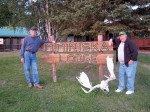
Miminiska Lodge is one of few Canadian lodges that has its own airstrip (CPS5). The grass runway (9/27) is 50 feet wide and 2400 feet long. Besides the single-engine aircraft in our group this year, twins and turboprops land at Miminiska on a regular basis.
Lodge manager, Tristan Yuswak of Australia, and his staff, met us at the airport with a four-wheeler and trailer to help transport our gear to our cabins. Tristan was an immigration enforcement officer in Australia prior to accepting his position at Miminiska, and understands the hospitality business very well. He is also a certified Emergency Medical Technician (EMT), which complemented the two doctors and two nurses we had in our group.
We cancelled our flight plans, got settled into our cabins, had lunch, and were in our boats by 1:30 pm.
The lodge had a reception for our group at 5:00 pm, and dinner at 6:00 pm. Most of us hung around after dinner to socialize, but some opted to go fishing again.
A pool table and satellite television are among the amenities available to guests, but I don’t recall anyone turning on the TV this year or last year.
The best entertainment is watching either the lodge’s turbine de Havilland Otter fly in on floats, or as was the case this year, an Ontario Ministry of Natural Resources 1967 Turbo Beaver on Wipline 6100 amphibious floats. This particular Beaver has 17,000 hours on it, and was flown by Bob Ernewein of Dryden, Ontario.
You have to have a lot of respect for these bush pilots who put in very long days, and are very skilled at docking, even in strong winds. On takeoff, the turbine engine of the Beaver resonated across the water, and of course, Bob had to make a low pass over the runway to check out our squadron of planes.
Among Wilderness North’s aircraft are three turbine de Havilland Otters on straight floats, a Beaver – also on straight floats – and several cargo aircraft and corporate jets used to shuttle people and supplies. A Pilatus owned by Wasaya Airlines flys in with many of the guests from Thunder Bay, and is a lifeline to many native villages.
Alan and Krista Cheeseman own Wilderness North, which includes Miminiska and four other lodges and 10 outposts in northern Ontario. Only Miminiska Lodge has an airstrip. All of the other lodges depend on floatplanes to transport guests.
Miminiska Lodge has an assortment of rustic, yet modern log and cedar-sided cabins of varying sizes, as well as rooms immediately adjoining the main lodge.
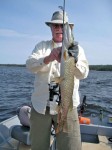
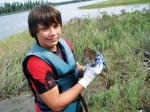
About the fishing this year, everyone in our group was more than pleased with the great abundance of Walleye and Northern, although the water was low. Last year the water was so high that the new dock was submerged.
There is no need for guides, as the lodge provides maps with the best fishing spots clearly marked. Some first-timers will hire a guide the first day to get familiar with the area, and that is understandable.
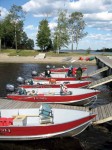 Catch and release is popular in Canada, and helps preserve the good fishing. The conservation license we bought enabled us to take two Northerns under 27 inches in length, and two Walleyes under 18 inches.
Catch and release is popular in Canada, and helps preserve the good fishing. The conservation license we bought enabled us to take two Northerns under 27 inches in length, and two Walleyes under 18 inches.
Probably the most popular lures for Walleyes at Miminiska are yellow, white and tan double tailed twisters or swirl tails on the end of a yellow jig with a black Berkley “Gulp” minnow. Live minnows work well, too. Northerns seem to bite on most anything. Staff at the lodge clean and freeze the fish for the flight home.
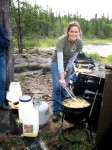
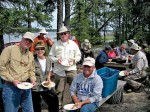
No matter where we were on this massive chain of lakes, we would all get together each day at noon at “Shore Lunch Island,” where the staff prepared our morning catch.
Our group was as diverse as they come: two doctors, two nurses, a manufacturer, engineer, airport restaurant owner, an attorney and a legal assistant, five farmers, and one magazine publisher. Once again, our common denominator was our love of aviation and adventure!
You do not have to be a hard-core fisherman to enjoy this trip. You just have to enjoy flying and the great outdoors!
 Most of the lakes in Canada are crystal clear, and the scenery from the air and on the ground is fantastic! After a few days in the Canadian wilderness, some of us asked ourselves, “Do I really have to go home?” Reality usually wins over fantasy.
Most of the lakes in Canada are crystal clear, and the scenery from the air and on the ground is fantastic! After a few days in the Canadian wilderness, some of us asked ourselves, “Do I really have to go home?” Reality usually wins over fantasy.
The night before we departed for home, we filed our flight plans with Winnipeg FSS. Whatever time we put down as our expected departure time from Miminiska, was the time Winnipeg FSS “activated” our flight plans.
 After a hardy breakfast the following morning, we took off and flew 62 nm to Pickle Lake (CYPL) to refuel and make a quick call to U.S. Customs & Border Protection at Ely to confirm or update our ETAs as filed on our Flight Manifests before we left home.
After a hardy breakfast the following morning, we took off and flew 62 nm to Pickle Lake (CYPL) to refuel and make a quick call to U.S. Customs & Border Protection at Ely to confirm or update our ETAs as filed on our Flight Manifests before we left home.
Pickle Lake has a 4921 X 100 ft. asphalt runway, weather computer, and a telephone. Again, each aircraft in our group kept in contact with one another on 122.75, and most climbed to 8,000 feet with the faster aircraft leading the way.
Before we left Canadian airspace and prior to crossing the border, we contacted Princeton Flight Service using the Ely VOR to get a discrete transponder code. Once again, we transmitted on 122.1 and listened over the Ely VOR on 109.6.
The dates for 2011 are August 17-21, with an optional stay-over in Thunder Bay on the 16th. A second trip is also being planned.
For rates and additional information, send me an email at info@midwestflyer.com, or call 608-835-7063. Also, be sure to check out the Wilderness North website at http://www.wildernessnorth.com where you will find lots of podcasts and fishing reports, including a report on this year’s fly-out. A podcast on the fly-out with Minneapolis radio personality, Al Malmberg of the “World of Aviation,” can be found on the Midwest Flyer Magazine website: www.midwestflyer.com.
Actual reservations are handled directly through Wilderness North in Thunder Bay. Make your reservations by December 20, 2010 and receive a substantial discount. Call 1-888-465-FISH (3474).
Ride share information is also available by contacting Midwest Flyer Magazine at info@midwestflyer.com.
EDITOR’S NOTE: The “Midwest Flyer Canadian Fishing Fly-Out to Miminiska Lodge” is a service of Miminiska Lodge, Wilderness North and its owners. Dave Weiman is acting only as a fellow participant on the trip, and neither he nor Midwest Flyer Magazine, Flyer Publications, Inc., nor their staff and owners, assume any liability for the participation of others on the trip or for the trip itself, and do not assume any responsibility for the reliance upon the information contained herein or which is provided or stated elsewhere, including Dave Weiman’s personal Flight Plan Guide. Federal Aviation Administration, Transport Canada, and U.S. and Canada Customs regulations and procedures are subject to change. Pilots are urged to use every resource available to them in planning their trip, including government publications and websites, fixed base operators, airport management, and pilot organizations. Any information provided by Midwest Flyer Magazine is subject to error and change, and requires personal verification by participants.